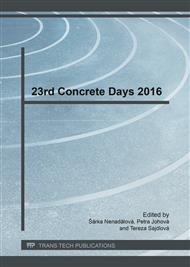p.227
p.232
p.238
p.244
p.249
p.255
p.263
p.269
p.275
Reliability of Existing Concrete Structures Determined with Physical Models - Carbonation Induced Corrosion
Abstract:
The main goal of transportation infrastructure management is to optimize the use of infrastructure in the most beneficiary way while respecting the predefined requirements. One of the crucial parts in management strategy is the prediction of behaviour of vital transportation elements. Used prediction models should accurately describe the process of degradation and allow forecasting of structural condition by considering environment, usage and maintenance actions. Deterioration models can be divided into mathematical (statistical), physical and empirical models. Statistical models are based on data that describe condition of structure, such as for example condition rating. Physical models describe damage-causing processes and empirical models are experience based. The focus of this paper is to present the physical model of carbonation in assessment of performance of existing reinforced concrete structures in transportation networks. Assessment is done through determining the probability of limit state of depassivation. In order to determine the carbonation without testing, a special attention has to be given to environmental and material parameter identification. Herein, the identification takes into account weather specifics and construction practice in Austria. Finally, the reliability of existing reinforced concrete structures for combination of different exposure classes and material characteristics is analysed. Based on the analysis of reliability, the carbonation nomogram for engineering use is presented, showing the reliability indices β for the service life of 50 years.
Info:
Periodical:
Pages:
255-260
Citation:
Online since:
May 2017
Authors:
Keywords:
Price:
Сopyright:
© 2017 Trans Tech Publications Ltd. All Rights Reserved
Share:
Citation:


